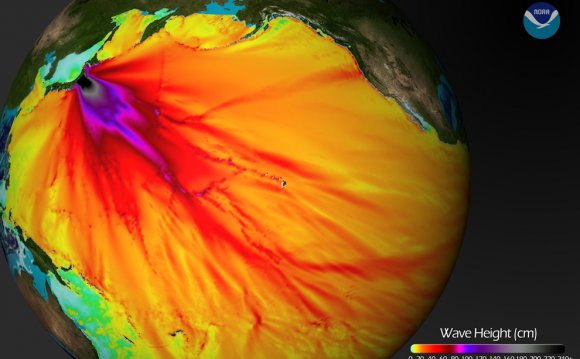
 A station for which seismic data is available. Not all stations will have data for a particular earthquake. Also, stations may become physically damaged and data is rendered unavailable. The time at which a seismic wave arrives at a seismometer. The image to the right shows a seismogram with the P wave and S wave arrival times marked. According to this example, the P wave arrived at the recording device shortly after 11:43 AM and the S wave arrived shortly before 11:45 AM. A section formed by a plane cutting through the Earth, at right angles to an axis. This allows one to see the interior composition of the Earth. Examples of cross section illustrations can be seen in the distance, focus, and lithosphere definitions in this glossary. Earthquakes can occur anywhere between the Earth's surface and about 700 kilometers below the surface. For scientific purposes, this earthquake depth range of 0 - 700 km is divided into three zones: shallow, intermediate, and deep. Shallow earthquakes are between 0 and 70 km deep; intermediate earthquakes, 70 - 300 km deep; and deep earthquakes, 300 - 700 km deep. In general, the term "deep-focus earthquakes" is applied to earthquakes deeper than 70 km. All earthquakes deeper than 70 km are localized within great slabs of shallow lithosphere that are sinking into the Earth's mantle. Distance is measured in degrees of arc, the common way of measuring distance on a sphere, and kilometers in REV. The illustration to the left demonstrates the distance in degrees of arc from an earthquake to a station. The station is located at 50 degrees while the earthquake is at 135 degrees. By subtracting 50 from 135, we get the degree of the angle created by the distance between the earthquake and station. This term is used to describe both sudden slip on a fault, and the resulting ground shaking and radiated seismic energy caused by the slip, or by volcanic or magmatic activity, or other sudden stress changes in the Earth. A fracture along which the blocks of crust on either side have moved relative to one another parallel to the fracture. Strike-slip faults are vertical (or nearly vertical) fractures where the blocks have mostly moved horizontally.
A station for which seismic data is available. Not all stations will have data for a particular earthquake. Also, stations may become physically damaged and data is rendered unavailable. The time at which a seismic wave arrives at a seismometer. The image to the right shows a seismogram with the P wave and S wave arrival times marked. According to this example, the P wave arrived at the recording device shortly after 11:43 AM and the S wave arrived shortly before 11:45 AM. A section formed by a plane cutting through the Earth, at right angles to an axis. This allows one to see the interior composition of the Earth. Examples of cross section illustrations can be seen in the distance, focus, and lithosphere definitions in this glossary. Earthquakes can occur anywhere between the Earth's surface and about 700 kilometers below the surface. For scientific purposes, this earthquake depth range of 0 - 700 km is divided into three zones: shallow, intermediate, and deep. Shallow earthquakes are between 0 and 70 km deep; intermediate earthquakes, 70 - 300 km deep; and deep earthquakes, 300 - 700 km deep. In general, the term "deep-focus earthquakes" is applied to earthquakes deeper than 70 km. All earthquakes deeper than 70 km are localized within great slabs of shallow lithosphere that are sinking into the Earth's mantle. Distance is measured in degrees of arc, the common way of measuring distance on a sphere, and kilometers in REV. The illustration to the left demonstrates the distance in degrees of arc from an earthquake to a station. The station is located at 50 degrees while the earthquake is at 135 degrees. By subtracting 50 from 135, we get the degree of the angle created by the distance between the earthquake and station. This term is used to describe both sudden slip on a fault, and the resulting ground shaking and radiated seismic energy caused by the slip, or by volcanic or magmatic activity, or other sudden stress changes in the Earth. A fracture along which the blocks of crust on either side have moved relative to one another parallel to the fracture. Strike-slip faults are vertical (or nearly vertical) fractures where the blocks have mostly moved horizontally. Dip-slip faults are inclined fractures where the blocks have mostly shifted vertically. Oblique-slip faults have significant components of both slip styles. The focus is the point within the Earth where an earthquake rupture starts. The epicenter is the point directly above it at the surface of the Earth. Distance from earthquakes and earthquake locations are measured from the epicenter. GMT stands for Greenwich Mean Time, sometimes called Greenwich Meridian Time because it is measured from the Greenwich Meridian Line at the Royal Observatory in Greenwich, England. The current GMT time is . your local time to convert it to GMT time. An angle with reference to, or pertaining to, the center of the Earth. The distance definition shows an illustration of a geocentric angle, which is formed by the locations of an earthquake and a recording station with reference to the apex at the center of the Earth. The movement of the Earth's surface from earthquakes or explosions. Ground motion is produced by waves that are generated by sudden slip on a fault or sudden pressure at the explosive source and travel through the Earth and along its surface. The outer solid part of the Earth, including the crust and uppermost mantle.
Dip-slip faults are inclined fractures where the blocks have mostly shifted vertically. Oblique-slip faults have significant components of both slip styles. The focus is the point within the Earth where an earthquake rupture starts. The epicenter is the point directly above it at the surface of the Earth. Distance from earthquakes and earthquake locations are measured from the epicenter. GMT stands for Greenwich Mean Time, sometimes called Greenwich Meridian Time because it is measured from the Greenwich Meridian Line at the Royal Observatory in Greenwich, England. The current GMT time is . your local time to convert it to GMT time. An angle with reference to, or pertaining to, the center of the Earth. The distance definition shows an illustration of a geocentric angle, which is formed by the locations of an earthquake and a recording station with reference to the apex at the center of the Earth. The movement of the Earth's surface from earthquakes or explosions. Ground motion is produced by waves that are generated by sudden slip on a fault or sudden pressure at the explosive source and travel through the Earth and along its surface. The outer solid part of the Earth, including the crust and uppermost mantle. The lithosphere is about 100 km thick, although its thickness is age dependent (older lithosphere is thicker). The locations of earthquakes and stations in REV are indicated by latitude and longitude. Latitude is measured in degrees starting at the equator, and will be either north or south depending on whether the earthquake or station is in the northern or southern hemisphere. Longitude is measured in degrees starting at the Prime Meridian and will be either east or west, depending on which hemisphere the earthquake or station is in. For example, you can see in the illustration to the right an earthquake southeast of Honshu that is in the eastern and northern hemispheres and is 33.2 degrees from the equator and 137.0 degrees from the Prime Meridian. A number that characterizes the relative size of an earthquake. Magnitude is based on measurement of the maximum motion recorded by a seismograph. Several scales have been defined, but the most commonly used are (1) local magnitude (ML), commonly referred to as "Richter magnitude, " (2) surface-wave magnitude (Ms), (3) body-wave magnitude (Mb), and (4) moment magnitude (Mw). Scales 1-3 have limited range and applicability and do not satisfactorily measure the size of the largest earthquakes. The moment magnitude (Mw) scale, based on the concept of seismic moment, is uniformly applicable to all sizes of earthquakes but is more difficult to compute than the other types. All magnitude scales should yield approximately the same value for any given earthquake.
The lithosphere is about 100 km thick, although its thickness is age dependent (older lithosphere is thicker). The locations of earthquakes and stations in REV are indicated by latitude and longitude. Latitude is measured in degrees starting at the equator, and will be either north or south depending on whether the earthquake or station is in the northern or southern hemisphere. Longitude is measured in degrees starting at the Prime Meridian and will be either east or west, depending on which hemisphere the earthquake or station is in. For example, you can see in the illustration to the right an earthquake southeast of Honshu that is in the eastern and northern hemispheres and is 33.2 degrees from the equator and 137.0 degrees from the Prime Meridian. A number that characterizes the relative size of an earthquake. Magnitude is based on measurement of the maximum motion recorded by a seismograph. Several scales have been defined, but the most commonly used are (1) local magnitude (ML), commonly referred to as "Richter magnitude, " (2) surface-wave magnitude (Ms), (3) body-wave magnitude (Mb), and (4) moment magnitude (Mw). Scales 1-3 have limited range and applicability and do not satisfactorily measure the size of the largest earthquakes. The moment magnitude (Mw) scale, based on the concept of seismic moment, is uniformly applicable to all sizes of earthquakes but is more difficult to compute than the other types. All magnitude scales should yield approximately the same value for any given earthquake. For REV the criteria for notable earthquakes is a greater than 5.5 for worldwide earthquakes and greater than 3 for earthquakes in the United States. Modern seismograph stations have three separate instruments to record seismograms - (1) one to record the north-south waves, (2) another to record east-west waves, and (3) a vertical one in which a weight resting on a spring tends to stand still and record vertical ground motions. This combination of instruments tells a seismologist the general direction of the seismic wave source, the magnitude at its source, and the character of the wave motion. The orientation of a seismogram refers to the direction of the waves recorded: north-south, east-west, or vertical. The precise time that an earthquake rupture occurs. On a seismogram, the earthquake origin time can be determined by the P wave arrival. P (Primary) waves are a type of body wave. A body wave is a seismic wave that moves through the interior of the Earth, as opposed to surface waves that travel near the Earth's surface. P and S waves are body waves. Each type of wave shakes the ground in different ways. A P wave, or compressional wave, is a seismic body wave that shakes the ground back and forth in the same direction and the opposite direction as the direction the wave is moving. P waves travel faster and are generally felt first. They usually cause very little damage. Seismograms plotted on a graph as a function of distance. This is a common way seismologists look at data from an earthquake. In REV's record sections, seismograms recorded by stations close to the earthquake are plotted to the left and seismograms recorded by more distant stations are plotted to the right. An S (Secondary) wave, or shear wave, is a seismic body wave that shakes the ground back and forth perpendicular to the direction the wave is moving. It is one of two types of body waves.
For REV the criteria for notable earthquakes is a greater than 5.5 for worldwide earthquakes and greater than 3 for earthquakes in the United States. Modern seismograph stations have three separate instruments to record seismograms - (1) one to record the north-south waves, (2) another to record east-west waves, and (3) a vertical one in which a weight resting on a spring tends to stand still and record vertical ground motions. This combination of instruments tells a seismologist the general direction of the seismic wave source, the magnitude at its source, and the character of the wave motion. The orientation of a seismogram refers to the direction of the waves recorded: north-south, east-west, or vertical. The precise time that an earthquake rupture occurs. On a seismogram, the earthquake origin time can be determined by the P wave arrival. P (Primary) waves are a type of body wave. A body wave is a seismic wave that moves through the interior of the Earth, as opposed to surface waves that travel near the Earth's surface. P and S waves are body waves. Each type of wave shakes the ground in different ways. A P wave, or compressional wave, is a seismic body wave that shakes the ground back and forth in the same direction and the opposite direction as the direction the wave is moving. P waves travel faster and are generally felt first. They usually cause very little damage. Seismograms plotted on a graph as a function of distance. This is a common way seismologists look at data from an earthquake. In REV's record sections, seismograms recorded by stations close to the earthquake are plotted to the left and seismograms recorded by more distant stations are plotted to the right. An S (Secondary) wave, or shear wave, is a seismic body wave that shakes the ground back and forth perpendicular to the direction the wave is moving. It is one of two types of body waves. The other type is the P wave. S waves are slower and much more destructive than P waves. A record written by a seismograph in response to ground motions produced by an earthquake, explosion, or other ground-motion sources. Seismograph is a term that refers to the seismometer and its recording device as a single unit. A seismometer is an instrument used to detect and record earthquakes. Generally, it consists of a mass attached to a fixed base. During an earthquake, the base moves and the mass does not. The motion of the base with respect to the mass is commonly transformed into an electrical voltage. The electrical voltage is recorded on paper, magnetic tape, or another recording medium. This record is proportional to the motion of the seismometer mass relative to the earth, but it can be mathematically converted to a record of the absolute motion of the ground. An assigned sequence of letters or letters and numbers that are 3 to 5 characters long, used to identify a particular station. Station names can often be long and this is a way for seismologists to quickly refer to or identify stations. The two letters and/or numbers you will see at the start of the station code in REV indicates the station's network code. For example, the code "US.NHSC" refers to a station in New Hope, South Carolina in the United States National Seismic Network. See a list of station codes available in REV. See a list of network codes available in REV. The assigned name for a station, which usually describes its location. A surface wave is a seismic seismic wave that is trapped near the surface of the earth, the opposite of a ("body wave"), which moves through the interior of the earth. The time required for a seismic wave to travel from its source to a recording device or seismometer. It can be calculated by subtracting the arrival time from the origin time. Zip code refers to the postal code used by the United States* Postal Service. ZIP stands for Zoning Improvement Plan, suggesting that mail travels faster when senders use it. The basic format consists of five numbers. ZIP Codes are numbered with the first digit representing a certain group of U.S. states, the second and third digits together representing a region in that group (or perhaps a large city), and the fourth and fifth digits representing more specific areas, such as small towns or regions of that city.
The other type is the P wave. S waves are slower and much more destructive than P waves. A record written by a seismograph in response to ground motions produced by an earthquake, explosion, or other ground-motion sources. Seismograph is a term that refers to the seismometer and its recording device as a single unit. A seismometer is an instrument used to detect and record earthquakes. Generally, it consists of a mass attached to a fixed base. During an earthquake, the base moves and the mass does not. The motion of the base with respect to the mass is commonly transformed into an electrical voltage. The electrical voltage is recorded on paper, magnetic tape, or another recording medium. This record is proportional to the motion of the seismometer mass relative to the earth, but it can be mathematically converted to a record of the absolute motion of the ground. An assigned sequence of letters or letters and numbers that are 3 to 5 characters long, used to identify a particular station. Station names can often be long and this is a way for seismologists to quickly refer to or identify stations. The two letters and/or numbers you will see at the start of the station code in REV indicates the station's network code. For example, the code "US.NHSC" refers to a station in New Hope, South Carolina in the United States National Seismic Network. See a list of station codes available in REV. See a list of network codes available in REV. The assigned name for a station, which usually describes its location. A surface wave is a seismic seismic wave that is trapped near the surface of the earth, the opposite of a ("body wave"), which moves through the interior of the earth. The time required for a seismic wave to travel from its source to a recording device or seismometer. It can be calculated by subtracting the arrival time from the origin time. Zip code refers to the postal code used by the United States* Postal Service. ZIP stands for Zoning Improvement Plan, suggesting that mail travels faster when senders use it. The basic format consists of five numbers. ZIP Codes are numbered with the first digit representing a certain group of U.S. states, the second and third digits together representing a region in that group (or perhaps a large city), and the fourth and fifth digits representing more specific areas, such as small towns or regions of that city.
*Unfortunately, at this time, REV can only support postal codes from the United States. If you know of a way that we could support international codes, please contact us at .
YOU MIGHT ALSO LIKE












